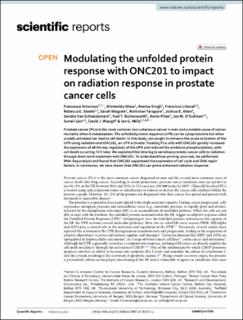| dc.contributor.author | Amoroso, Francesca | |
| dc.contributor.author | Glass, Kimberley | |
| dc.contributor.author | Singh, Reema | |
| dc.contributor.author | Liberal, Francisco | |
| dc.contributor.author | Steele, Rebecca E. | |
| dc.contributor.author | Maguire, Sarah | |
| dc.contributor.author | Tarapore, Rohinton | |
| dc.contributor.author | Allen, Joshua E. | |
| dc.contributor.author | Van Schaeybroeck, Sandra | |
| dc.contributor.author | Butterworth, Karl T. | |
| dc.contributor.author | Prise, Kevin | |
| dc.contributor.author | O’Sullivan, Joe M. | |
| dc.contributor.author | Jain, Suneil | |
| dc.contributor.author | Waugh, David J. | |
| dc.contributor.author | Mills, Ian | |
| dc.date.accessioned | 2022-04-21T08:20:40Z | |
| dc.date.available | 2022-04-21T08:20:40Z | |
| dc.date.created | 2022-01-18T14:20:57Z | |
| dc.date.issued | 2021 | |
| dc.identifier.issn | 2045-2322 | |
| dc.identifier.uri | https://hdl.handle.net/11250/2991842 | |
| dc.description.abstract | Prostate cancer (PCa) is the most common non-cutaneous cancer in men and a notable cause of cancer mortality when it metastasises. The unfolded protein response (UPR) can be cytoprotective but when acutely activated can lead to cell death. In this study, we sought to enhance the acute activation of the UPR using radiation and ONC201, an UPR activator. Treating PCa cells with ONC201 quickly increased the expression of all the key regulators of the UPR and reduced the oxidative phosphorylation, with cell death occurring 72 h later. We exploited this time lag to sensitize prostate cancer cells to radiation through short-term treatment with ONC201. To understand how priming occurred, we performed RNA-Seq analysis and found that ONC201 suppressed the expression of cell cycle and DNA repair factors. In conclusion, we have shown that ONC201 can prime enhanced radiation response. | en_US |
| dc.language.iso | eng | en_US |
| dc.publisher | Nature | en_US |
| dc.rights | Navngivelse 4.0 Internasjonal | * |
| dc.rights.uri | http://creativecommons.org/licenses/by/4.0/deed.no | * |
| dc.title | Modulating the unfolded protein response with ONC201 to impact on radiation response in prostate cancer cells | en_US |
| dc.type | Journal article | en_US |
| dc.type | Peer reviewed | en_US |
| dc.description.version | publishedVersion | en_US |
| dc.rights.holder | Copyright 2021 The Author(s) | en_US |
| dc.source.articlenumber | 4252 | en_US |
| cristin.ispublished | true | |
| cristin.fulltext | original | |
| cristin.qualitycode | 1 | |
| dc.identifier.doi | 10.1038/s41598-021-83215-y | |
| dc.identifier.cristin | 1983693 | |
| dc.source.journal | Scientific Reports | en_US |
| dc.identifier.citation | Scientific Reports. 2021, 11, 4252. | en_US |
| dc.source.volume | 11 | en_US |
| dc.source.issue | 1 | en_US |

